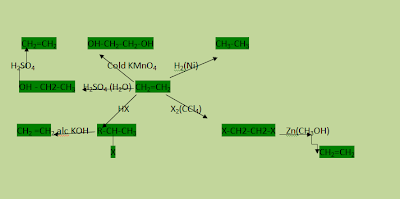ADSORPTION:
The
phenomena of attracting and retaining the molecules of a substance on
the surface of a liquid or a solid resulting into a higher
concentration of the molecules on the surface is called adsorption.In other words it is the phenomenon to collect molecules of solute on the top surface of solid or liquid . There is a electrostatic force build between solute and surface molecules because surface contains pores .Solute molecules incoperate in these pores. Solute particles or the molecules retained by the surface are called Adsobate and the surface on which these molecules adhere is called Adsorbent.
Adsorption is a different term than Absorption ,in which whole volume is involved i.e solute molecules penetrate in to the the matrix of solid or volume of liquid. The adsorption of
gases on the surface of metals is called occlusion.Now the question is why adsorption is a surface phenomenon ,as adsorbent(Solid,liquid or gas)have some bonding sites which are occupied by neighboring atoms in the bulk.This pocess keeps on going until all the available bonding sites are occupied .But there are bonding site available on the surface also.So these surface bonding sites in order to achieve stability adsorb some external molecules (adsorbate).
Adsorbate when form first layer on the adsorbent it is known as monolayer .Multilayer adsorption occur when more then one layer is formed .Multilayer adsorption can be random or it can be non random depending upon conditions .The first layer which is formed is capable of good adhesion as compared to the multilayers formed after it(depends also on which type of forces present vander wal or covalent forces) .If weak forces exist between adsorbate and adsorbent vander wall forces this is known as Physiosorption and if strong forces say covalent bonding exists then it is known as Chemisorption .
Decolourization of water is the wonder of adsorption.Adsorption is every where you can see it all around you.Almost everything is adsorbed on some kind of adsorbent.It can be seen in natural systems in physical ,biological ,chemical systems also .We are adsorbate also(Physical adsorption on the surface of earth. Hence adsorption is one of those phenomenon whse importance can not be denied in any sense.
Adsorption plays an important role in purification of indusrical waste water ,adsorbents adsorb many toxic metals and decolourized various dyes .These metals are cadmium ,chromium ,copper,maganese, zinc ,etc. Many industries such as paper ,textile ,cosmetics uses dyes to colour thier final product these dyes are highly dangerous and can cause serious hazardous problems .many techniques have been developed but adsorption prove to be most efficient and low cost.
Common adsorbents are activated carbon ,silica gel and alumina .But these adsorbents are of high cost .Studies have revealed that waste bio mass adsorbents are efficicient and low cost these are banana peel waste ,rice husk,tea waste ,coconut shells,egg shells,almound shells and many other fruit peels.
PROCESS OF ADSORPTION:
The process of
adsorption arises due to presence of unbalanced or residual forces at the
surface of liquid or solid phase. These unbalanced residual forces have
tendency to attract and retain the molecular species with which it comes in
contact with the surface. Adsorption is essentially a surface phenomenon.
Adsorption is a term
which is completely different from Absorption .While absorption means uniform
distribution of the substance throughout the bulk, adsorption essentially
happens at the surface of the substance. When both Adsorption and Absorption
processes take place simultaneously, the process is called sorption.
Adsorption process
involves two components Adsorbent and Adsorbate. Adsorbent is the substance on
the surface of which adsorption takes place.Adsorbate is the substance which is
being adsorbed on the surface of adsorbent.
TYPES OF ADSORPTION
Adsorption can be
classified into two categories as described below:
(1) Depending upon the concentration :
In adsorption the
concentration of one substance is different at the surface of the other substance
as compared to adjoining bulk or interior phase.
(i) Positive adsorption :
If the concentration of
adsorbate is more on the surface as compared to its concentration in the bulk
phase then it is called positive adsorption.
(ii) Negative adsorption :
When the concentration of adsorbate is more in bulk than its concentration on surface.Example of it is shaking of blood charcoal with dilute solution of KCl
(2) Depending upon the nature of force existing between
adsorbate molecule and adsorbent
(i) Physical adsorption :
If the forces of
attraction existing between adsorbate and adsorbent are Vander Waal’s forces,
the adsorption is called physical adsorption. This type of adsorption is also
known as physisorption or Vander Waal’s adsorption. It can be easily reversed
by heating or decreasing the pressure.
(ii) Chemical adsorption :
If the forces of
attraction existing between adsorbate particles and adsorbent are almost of the
same strength as chemical bonds, the adsorption is called chemical adsorption.
This type of adsorption is also called as chemisorption or Langmuir adsorption.
This type of adsorption cannot be easily reversed.
FACTORS WHICH AFFECT THE EXTENT OF
ADSORPTION.
The following are the
factors which affect the adsorption:
(a) Nature of the adsorbate (gas) and adsorbent
(solid)
(b) Surface area of the solid adsorbent
(c) Effect of pressure on the adsorbate gas
(d) Effect of temperature
Difference between Adsorption and Absorption:
ADSORPTION
- It is surface phenomenon i.e.
it occurs only at the surface of the adsorbent.
- In this phenomenon, the
concentration on the surface of adsorbent is different from that in the
bulk.
- Its rate is high in the
beginning and then decreases till equilibrium is attained.
|
ABSORPTION
- It is bulk phenomenon i.e. it
occurs throughout the body of the material.
- In this phenomenon, the
concentration is same throughout the material.
- Its rate remains same
throughout the process.
|










.jpg)





